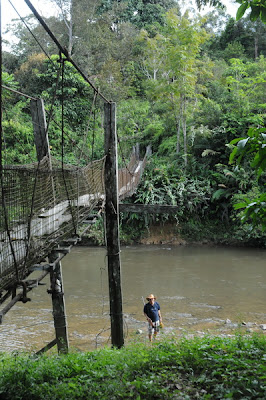Isai Raja, whose fruit farm was featured in my last post, is a member of the Kelabit people. The Kelabit hail from the highlands of eastern Sarawak, an area I had long wanted to visit, so when Isai invited me to join him on a visit to his homeland I was delighted to accept. On January 14, 2012, Isai, his brother Barahim, and I flew over the lowlands along the Baram River…
...to Long Banga, one of the few airports in the Kelabit Highlands. The area around Long Banga itself has been heavily logged, and as if that wasn't enough it was the site of a disastrous forest fire over a decade ago.
Isai's plan was to take me off into the forest to see birds (and to give him, and the residents of the highland kampungs, some idea of the potential of the area as a birding tourism destination). A combination of rain, road conditions and outside events changed our plans considerably over the ensuing week, but it was still a memorable experience, in a very lovely and surprisingly rich area of Sarawak.
This was, in part at least, a family visit, so our first stop was to see Isai's parents at their rice farm.
The slogan on Isai's mother's shirt urges readers to vote for the Barisan Nasional, the national coalition that has governed Malaysia since independence. The couple are sitting next to a traditional hearth, or tetel, once the centre of life for the Kelabit community.
...to Long Banga, one of the few airports in the Kelabit Highlands. The area around Long Banga itself has been heavily logged, and as if that wasn't enough it was the site of a disastrous forest fire over a decade ago.
Isai's plan was to take me off into the forest to see birds (and to give him, and the residents of the highland kampungs, some idea of the potential of the area as a birding tourism destination). A combination of rain, road conditions and outside events changed our plans considerably over the ensuing week, but it was still a memorable experience, in a very lovely and surprisingly rich area of Sarawak.
This was, in part at least, a family visit, so our first stop was to see Isai's parents at their rice farm.
The slogan on Isai's mother's shirt urges readers to vote for the Barisan Nasional, the national coalition that has governed Malaysia since independence. The couple are sitting next to a traditional hearth, or tetel, once the centre of life for the Kelabit community.
Our goal for the day was Long Peluan, a kampung to the north along a tributary of the Baram River, close to an increasingly scarce patch of unlogged dipterocarp forest. For the benefit of non-Malaysians, Selamat Datang, the legend over the gateway to the village, means "welcome" in Bahasa Malaysia.
As I quickly learned, the people of Long Peluan (and indeed of every place I visited in the Highlands) are as good as their word.
Though its architecture has been westernized, the building style at Long Peluan (and indeed in other highland kampungs) is still based around the longhouse: a very long house indeed, with individual living areas all opening out onto a lengthy common hall.
At one end, used for formal receptions and community meetings, the walls are painted with traditional designs, their curlicues apparently based on the upcurved casque of the Rhinoceros Hornbill (Buceros rhinoceros).
The main feature of the hall is the traditional tetel, its upper level stacked with firewood.
Its posts are hanging places for trophies: the antlers of a Muntjac or Barking Deer (Muntiacus muntjak) and the display plume of a male Great Argus Pheasant (Argusianus argus).
Raffia baskets and bamboo fish traps hang from the walls, ready for use.
There are smaller buildings, too, often used for storage; I found myself referring to these as "shorthouses", but I doubt that the term will catch on!
Barahim arranged for us to take an afternoon boat trip along the river that runs past the kampung. We saw very little wildlife; the only birds of note were the disappearing shapes of what were probably a pair of Bushy-crested Hornbills (Anorrhinus galeritus)flying into the forest. According to the people at Long Peluan, this is the common hornbill in the area - but a brief glimpse was all I was able to get.
Instead, we watched the winged fruits of dipterocarp trees, pinwheeling constantly into the waters below to be snapped up by waiting fishes.























+DSC_7210.JPG)
No comments:
Post a Comment